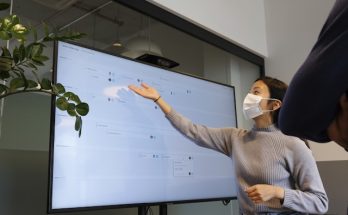Library of Congress. Image credit: Twitter handle
#LibraryOfCongress; #JapaneseRareBook; #DigitalCollection; #AsianDivision; #NINJAL
Washington/Canadian-Media: Launched in December 2020, the Japanese Rare Book Digital Collection, currently contains 35 titles in more than 270 volumes, twenty-five of which are rare books newly digitized, while the remaining ten titles were first scanned and made available online several years ago, Library of Congress (LoC) reported.
Only recently, these collections were assembled as a collection and configured for viewing on the Library’s updated platform for digital content, some of which contain rare and beautifully illustrated works of classical Japanese literature that have drawn attention from scholars around the world.
Two unique editions of the famous 11th-century work “The Tale of Genji,” which is attributed to Murasaki Shikibu (c. 978–c. 1014), a lady-in-waiting at the imperial court in Kyoto (then known as Heiankyō ) are of particular interest.
One of the two sets of “The Tale of Genji” held by the Asian Division is illustrated with a woodblock print edition produced in Kyoto in the mid-17th century.
The main text in 54 volumes, also includes six additional volumes consisting of commentaries, a genealogy, an index, and an extra chapter written by a later, unknown author.

The other set of “The Tale of Genji” is a manuscript edition that dates to the early 16th century, which was unknown to scholars until the LoC acquired it in 2008.
The Asian Reading Room of LoC which housed the manuscript edition was visited by several specialists in classical Japanese literature between 2010 and 2012, to carefully survey and document it as part of a project led by the National Institute for Japanese Language and Linguistics (NINJAL). NINJAL’s website reveals the results of their work in both English and Japanese. Although just three of the 54 volumes in this older set have been currently digitized, plans are underway to digitalize all the volumes.
An innovative display method making use of these three digitized volumes is adopted by the staff at NINJAL to allow readers to view the team’s expert transcription of the handwritten manuscript alongside the original text or superimposed over it.

Also present in the digital collection are four examples of Nara ehon, or “Nara picture books,” a style of manuscript book adorned with hand-painted color illustrations produced between the late 15th and early 18th centuries. Among the titles are “Hōmyō dōji” ほうみやう童子 (Marvelous Dharma Child), “Shigure” しくれ (Autumn Shower), “Shizuka” 靜 (The Tale of Shizuka), and “Soga monogatari” 曽我物語 (The Tale of the Soga Brothers).
These unique editions were studied by Professor Elizabeth Oyler, a specialist in premodern Japanese literature both online and in-person in the Asian Reading Room. More information about “Shizuka” and “Soga Monogatari,” is provided by consulting her article “Japanese Cultural Treasures at the Library of Congress: Digitization of the Rare Books Collection,” which appeared in the October 2007 issue of the open-access “Journal of East Asian Libraries.”
The recently digitized materials in the collection enable readers to discover a number of books in classical Chinese including texts first produced in China that were later reprinted or hand-copied in Japan, often with notes and annotations added.
Also included are works by Japanese authors writing in classical Chinese, or kanbun 漢文 (Chinese writing) as it is called in Japan.
Regardless of origin, recently digitized materials encompass a broad range of topics: Buddhist sutras; Chinese rhyme dictionaries; Confucian critiques of Christianity; military arts and strategy; world geography; and writing implements, among many others. The diversity of these works reflects the widespread importance that classical Chinese played as a written lingua franca for transmitting ideas and culture across East Asia prior to the 20th century.
Found in these materials is an interesting example of Japanese scholarship, a partial set of a lightly illustrated 1643 book titled “Hochū sōkikan” 補註相驥鑑 (A Guide to Judging Horses, Annotated), based on the 1639 work “Sōkikan” 相驥鑑 by Kurosawa Sadayuki 黑澤定幸 (d. 1671). Kurosawa, was a samurai who worked as a caretaker of horses (umaazukari 馬預) in direct service to the Tokugawa shogunate, the central military government that ruled Japan from its seat of power at Edo (Tokyo) between 1603 and 1868.
Kurosawa, in this book, compiles a comprehensive guide for evaluating the quality of a horse based on its appearance a practice also known as horse physiognomy, by drawing on a variety of historical Chinese texts and other sources to provide information on raising and caring for horses, with detailed sections on anatomy, diseases, and medical treatment. Also featured in this book is an introduction by Kurosawa’s former teacher, Hayashi Razan (1583–1657), a famous scholar who served as a tutor to four shoguns.

A richly illustrated study of bamboo by Okamura Shōken 岡村尚謙 (d. 1837) called “Keien chikufu” 桂園竹譜 (A Genealogy of Bamboo by Keien) is yet another newly available title of note in which Okamura was a doctor and natural scientist who served as an official physician to the lord of Takaoka domain in Shimōsa province, now part of present-day Chiba prefecture.
The “Keien” in the title refers to Okamura’s pen name. Besides, scientific descriptions of the bamboo plant, the work documents historical and literary references to bamboo and contains numerous color illustrations.

These few brief highlights would encourage interested general readers and specialists to explore the Japanese Rare Book Digital Collection, which is the latest effort by the Asian Division to make its collection materials more accessible to worldwide audiences. It follows two earlier releases, the Japanese Censorship Collection in April 2018 and the Ainu and Ezochi Rare Collection in April 2020.





